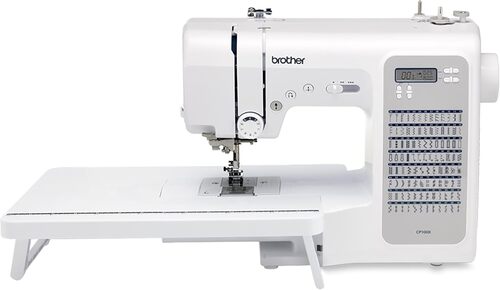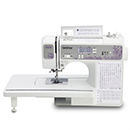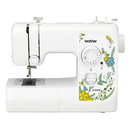
First Impressions: The Box on My Doorstep
The morning the big box landed on my doorstep, I felt like a kid on a snow day. For weeks I’d been reading Brother CP100X reviews, comparing specs, and second-guessing myself. My old hand-me-down machine had started skipping stitches right when I promised a baby quilt to my sister. I needed a dependable partner — something friendly, not fussy. That’s how the Brother CP100X sewing machine moved from my wish list to my porch.
Unboxing Jitters, Instant Calm
Inside the box: the Brother CP100X Sewing & Quilting Machine, a simple dust cover, an extension table, and a tidy lineup of presser feet — including a walking foot and a quilting foot. (Bless you, included accessories.) The cover is basic, not fancy, but it keeps dust off. The extension table puzzled me for a minute… until I remembered a tip I’d seen while skimming Brother CP100X reviews: pop off the little front accessory tray first, then the table slides on like it was made for it — because it was.
Quick & Friendly Setup
What eased my nerves fastest was the QR code on the front of the machine. One scan and a short video showed threading, bobbin winding, and needle threading. The thread path is numbered right on the frame. I learned one tiny trick: lift the needle all the way up before using the built-in needle threader, then press the lever with a gentle, confident nudge. Click — thread through the eye, no squinting, no drama.
Start/Stop Confidence (No Pedal Needed)
I didn’t even plug in the foot pedal at first. The Start/Stop button and speed slider are right above the needle, so I could crawl through the first seam at grandma-snail pace and then nudge faster when I felt brave. The motor purred instead of rattling, the LED lit the plate, and the drop-in bobbin showed me exactly how much thread I had left. All very “you’ve got this.”
First Stitch Test: The Store-Bought Tote
My warm-up project was a canvas tote. I picked a straight stitch, left the default length, and eased the fabric under the foot. The feed dogs pulled evenly; my job was mostly steering. When I switched to a little zigzag to tame a raw edge, the stitch was clean and the tension behaved. The edge looked so neat that I immediately turned scraps into two quick napkins because, well, momentum.
Projects for a New Baby
Next came the baby things — burp cloths, a flannel blanket, tiny bibs. I loved scrolling through the 100 utility and decorative stitches for cute borders. Nothing wild, just little hearts and a gentle wave. The screen kept telling me which foot to use so I didn’t grab the wrong one mid-project. Buttonholes were refreshingly simple too: slide in the button, snap on the foot, press go. Are they couture on silk charmeuse? No. But on cotton and quilting cotton, they’re tidy and consistent.
Quilting Weekend: Walking Foot to the Rescue
I cleared the dining table and clipped on the extension table. (Again: accessory tray off, extension table on.) With a fresh 90/14 needle and the walking foot attached, I stitched rows through a patchwork top and cotton batting. The Brother CP100X stayed steady, even over the bulky seams. I did hit the classic “denim mountain” test on a picnic quilt later — eight layers in a corner. With a hump jumper and slow speed, it climbed. Is this an industrial? Nope. But for a home machine, it held its own if I respected physics and used the right needle.
Real-World Hiccups & Easy Fixes
- Tension gremlins on slinky knits: If I forget to rethread with the presser foot up (so the tension discs open), I’ll get a little bird’s nest under the fabric. Rethread and slow down — fixed.
- Bobbin winding: Gentle, even finger tension during the first few winds keeps the bobbin from going cone-shaped.
- Lightweight body: I use a silicone mat so it doesn’t slide on my glossy table when wrangling a big quilt.
- Dust cover: It’s basic. It covers dust. That’s it.
- No automatic thread cutter: I keep snips on a magnetic hook and move on.
Free-Motion Courage Booster
A month in, I dropped the feed dogs, swapped to the quilting foot, took a deep breath, and tried free-motion on a potholder. The Brother sewing machine CP100X gave me smooth, even stitches once I balanced speed and hand movement. The speed slider was a secret weapon; I set a comfortable ceiling so my foot — or rather my Start/Stop button — couldn’t accidentally floor it. That little safety net built my confidence faster than any pep talk.
Garments & Denim: Everyday Wins
One Saturday I made a simple cotton dress for my daughter with pockets (because pockets are policy). Straight seams looked crisp, topstitching was even, and the buttonholes lined up like soldiers. On denim hems I took it slow, switched to a jeans needle, and let the walking foot do the heavy lifting. The CP100X didn’t throw a fit or chew my fabric — two things my old machine did regularly.
Six Months Later — The Highlights
- Friendly brain, not fussy brains: Clear screen, foot suggestions, sensible defaults, and 100 stitches that cover real sewing.
- Start/Stop + speed control: Great for long seams, teaching my niece, and no-pedal days.
- Quilting-ready out of the box: Walking foot, quilting foot, and extension table included.
- Quiet and light: Easy to tote to sewing nights, doesn’t drown out podcasts.
- Drop-in bobbin & needle threader: Small features, big sanity.
Caveats to Know
- Not a heavy-duty tank: Leather bags every weekend? You’ll want something beefier.
- Decorative stitches on heavy fabrics: They can look cramped; best on quilting cottons and lighter wovens.
- Minimal storage tray: I keep feet in a small zip case.
- No auto thread cutter: If that’s a must-have, note it.
Projects I’ve Finished (So Far)
- A patchwork baby quilt with simple straight-line quilting
- Canvas totes with wave-stitch borders
- Two sets of curtains (hemming at a calm, slow pace = chef’s kiss)
- A denim picnic blanket that survived the “corner mound” test
- Bibs, burp cloths, and a soft flannel blanket
- A cotton day dress with neat buttonholes and tidy topstitching
Who Will Love the Brother CP100X
If you’re moving up from a basic beginner model and want features that actually help — clear stitch selection, reliable feed, start/stop, included quilting gear — the Brother CP100X is a sweet spot. If you need a travel machine for classes or retreats that can still handle a real quilt, it’s a yes. If you’re shopping machines by reading piles of Brother CP100X reviews like I did, here’s the short version: it’s easy to live with, honest about its limits, and surprisingly capable inside them.
Why I’d Buy It Again
- Real value: The accessories bundle saves money later.
- Confidence builders: Visible bobbin, speed limiter, foot prompts.
- Versatility: From baby gifts to quilts to everyday hemming.
- Low fuss, high payoff: It gets out of my way and lets me sew.
Final Stitch: My Brother CP100X Review
So, this is my honest, first-person Brother CP100X review after months of real projects and real messes. The Brother CP100X sewing machine doesn’t try to be everything; it focuses on being friendly, steady, and ready. And that’s exactly what I wanted. If you’re debating, I’ll say what I wish someone had told me sooner: open the box, thread it, press Start, and let the stitches do the convincing.
What real owners say in their Brother CP100X reviews?
| Pros (What customers praise) | Cons (What customers dislike) |
|---|---|
| Easy to use / beginner-friendly. Many first-timers and returning sewists say the Brother CP100X is simple to set up and learn; clear instructions, QR video help, and intuitive controls. | Setup can still trip some users. A minority report confusion with threading or initial learning; a few even say it’s “not for beginners.” |
| Great value for money. Frequent mentions of “worth the price” and “huge value,” especially versus mechanical models. | Plastic feel & basic cover. Several note lightweight plastics, a flimsy dust cover, and a minimal accessory tray. |
| Good stitch quality on everyday fabrics. Owners praise straight stitches and neat zigzag on cottons and common projects. | Decorative stitches/buttonholes inconsistent on some fabrics. A few report uneven buttonholes, thread breaks, or decorative stitches struggling on denim/silk. |
| Quilting-ready out of the box. Included walking foot, quilting foot, and extension table earn lots of love; people finish quilts, totes, and bindings. | Not heavy-duty. Multiple users say thick seams/very bulky layers can be a challenge; expect to slow down, use the right needle, or a walking foot—still not an industrial. |
| Drop-in bobbin & easy bobbin winding. Many cite smooth winding and visible bobbin as confidence boosters. | Occasional bobbin/thread issues. Isolated reports of uneven bobbin winding or thread jumping the guide causing nests under fabric. |
| Needle threader helps a lot. Once learned, most find it reliable and time-saving. | Threader can be finicky at first. A few call it hit-or-miss until technique clicks. |
| Quiet motor & smooth sewing. Often described as “quiet,” “purrs,” and comfortable for home use. | Noise/QC outliers. A handful mention random noises, squeaks, or misaligned needles on their unit. |
| Speed control + Start/Stop (pedal optional). Loved by beginners, teens, and people with mobility/back issues; easy to go very slow. | Lightweight can slide. Because it’s portable, some place it on a grippy mat so it doesn’t move when handling larger projects. |
| Lightweight & portable. Popular as a travel/retreat machine or for taking to classes. | Extension table fit confusion. A few thought it didn’t fit—(tip from reviewers: remove the small front accessory tray first, then slide the table on). |
| Strong community feedback for gifts. Many bought it for kids/teens or family; they’re sewing successfully. | Packaging/parts issues. A few mention missing attachments, case/foam confusion, or needing to return/exchange. |
| Holds up for everyday sewing. Multiple owners report months to a year+ with consistent results across quilts, garments, home décor. | Failure/return stories exist. Isolated reports of early failures, jamming, or “stopped working,” plus Amazon support frustration. |
| Clear “foot prompts” and helpful defaults. Users like the stitch presets and foot guidance. | No automatic thread cutter. A few wish the Brother CP100X sewing machine included this convenience feature. |
Brother CP100X — Your Most-Asked Questions Answered
What is the Brother CP100X and who is it for?
The Brother CP100X Sewing & Quilting Machine is a computerized home sewing machine with simple controls, a Start/Stop button, speed slider, and an LCD that shows stitch, foot letter, width and length—great for beginners and returning sewists who want easy setup with room to grow. The panel displays the active stitch and presser-foot suggestion so you pick the right foot without guesswork.
Does the Brother CP100X have a Start/Stop button and can I sew without the foot pedal?
Yes. You can sew with the Start/Stop button and the speed controller. If the foot controller is connected, the Start/Stop button is disabled—unplug the pedal to use button-sewing.
Which bobbins does the Brother CP100X sewing machine use?
Use Brother SA156 bobbins (Class 15, 11.5 mm high). Using the correct bobbin type prevents jams and tension issues.
What is the quick-set (drop-in) bobbin and do I need to pull up the bobbin thread first?
The CP100X includes a quick-set bobbin system; after you drop the bobbin in and follow the slit/cutter path, you can start sewing without manually drawing up the bobbin thread.
How many stitches are available and where can I see them?
The stitch patterns vary by model version, and you can view the full Stitch Chart for the Brother CP100X on Brother’s support site; it lists each stitch, recommended foot, width and length.
Does the Brother sewing machine CP100X do automatic reverse or tie-offs?
You can enable an automatic reverse/reinforcement function so the machine adds securing stitches at the beginning and end of seams. Turn this on in the settings menu.
What needle sizes and threads should I use for different fabrics?
Use home sewing needles 65/9–100/16 and thread weights #30–#90. Lightweight fabrics use finer needles/shorter stitches; denim/canvas need 90/14–100/16 with heavier thread. Brother’s table in the manual gives pairings to avoid skipped stitches or puckering.
Can the Brother CP100X sew buttonholes? What’s the maximum length?
Yes—use buttonhole foot “A”. The maximum buttonhole length is about 28 mm (≈1-1/8 in), and the machine sews the bar tacks automatically at the end.
Does the Brother CP100X support a twin needle?
Yes. Switch the machine to Twin Needle mode, install the extra spool pin, and keep the stitch width at 5.0 mm or less to avoid needle strikes. Thread the twin needles by hand (the auto-threader can’t be used) and use zigzag foot “J.”
How do I stop thread nests and tension problems on the Brother CP100X?
Bird’s nests usually come from incorrect threading. Rethread the upper path carefully, ensure the bobbin is correctly inserted, and return the tension dial to the normal setting before fine-tuning. The manual’s troubleshooting section shows symptoms and quick fixes.
Is the Brother CP100X review of maintenance complicated—do I need to oil it?
Maintenance is simple: keep lint out of the race (drop-in area) and do not oil the machine yourself. Brother pre-oils it at the factory; user oiling can damage it. Remove the needle plate to clean the race if you get jams, then reassemble.
How do I attach the extension/wide table if it seems not to fit?
First slide off the flat-bed attachment/accessory compartment; the free-arm is exposed only when that piece is removed. Then slide the optional wide table straight on so it locks flush. (The manual shows removing the flat-bed attachment to use the free-arm—the same step you do before attaching a table.)
Can I adjust top speed on the Brother CP100X sewing machine?
Yes. The speed slider limits maximum speed, and there’s a setting to cap the machine to a slower overall mode for extra control—handy for beginners or precision work.
What feet and accessories work with the Brother CP100X Sewing & Quilting Machine?
The manual lists optional feet like a walking foot, 1/4˝ piecing foot, quilting foot/guide, zipper foot, buttonhole foot, and a wide table. Use Brother-recommended parts for best results.
Why does the Start/Stop button beep or not run?
If the presser foot is raised, the bobbin-winder is engaged, the foot pedal is plugged in, or the buttonhole lever is in the wrong position, the machine will stop and beep. Lower the foot, disengage the winder, unplug the pedal (to use Start/Stop), or set the buttonhole lever correctly.
Any quick setup tips from real-world Brother CP100X reviews?
Common wins in Brother CP100X reviews include: easy threading and bobbin winding, smooth and quiet operation, a handy speed slider for learners, and good value with quilting-friendly features. Frequent tips: use the right needle/thread for thick layers, remove the flat-bed piece before sliding on an extension table, and rethread from scratch if you see nests under the fabri
Where can I find more help for the Brother CP100X review process—stitches, videos, and guides?
Brother hosts instruction videos, the Sewing Guide, and the full Stitch Chart online, which many owners reference when exploring new stitches or troubleshooting.
| Feature | Specification |
|---|---|
| Model | Brother CP100X Computerized Sewing & Quilting Machine (household use) |
| Manual product code family | Operation Manual Product Code: 888-N00/N02/N20/N22/N40/N42/N60 |
| Machine type & controls | Computerized sewing machine with operation panel (LCD shows stitch number, presser-foot indicator, stitch length/width, needle stop position, needle mode) and dedicated operation buttons. |
| Operation buttons | Reverse/Reinforcement, Start/Stop*, Needle Up/Down*, Speed Slider*. (*available on equipped models) |
| Speed management | Two maximum-speed modes (Standard / Slower); speed slider also limits foot-controller top speed. |
| Foot controller | Household foot controller; when connected, the Start/Stop button is disabled (on models with Start/Stop). |
| Automatic reverse / reinforcement | Can be set to auto at the beginning and end of seams. |
| Needle modes | Single-needle and Twin-needle modes (selectable). |
| Twin-needle use | Supports Brother twin needle (part code X59296-121); set Twin-needle mode and follow stitch limits shown in the Stitch Chart. |
| Buttonholes | Automatic buttonhole sewing; maximum finished buttonhole length approx. 28 mm (1-1/8″). |
| Thread range | Compatible thread weights #30–#90 (do not use #20 or lower). |
| Needle system / sizes | Home sewing machine needles, sizes 65/9–100/16; ball-point recommended for knits; topstitching needle for transparent nylon thread. |
| Fabric guidance | Reference table for lightweight to heavyweight fabrics (e.g., quilting cotton, denim) with suggested needle sizes and stitch lengths. |
| Bobbin system | Uses Brother SA156 bobbin (Class 15 type), 11.5 mm height; Quick-Set drop-in bobbin on equipped models. |
| Quick-Set bobbin start | On models with Quick-Set: insert and cut—sew without manually drawing up bobbin thread. |
| Free arm | Convertible free-arm for tubular items (via flat-bed attachment). |
| Included accessories | Varies by package; see the “Included Accessories” sheet supplied with the machine. |
| Optional accessories (examples) | Walking foot (SA140), Quilting foot (SA129), 1/4″ Piecing foot (SA125), Quilting guide (SA132), Twin needle (X59296-121), Extra spool pin, Wide table (SAWT7/WT17), SA156 bobbins, etc. |
| Maintenance | User oiling not required; routine cleaning of race and machine surfaces recommended. |
| Power | Regular household AC power with main power switch; follow regional electrical guidance and safety instructions. |
| Documentation & stitch chart | Latest manuals and stitch chart available via Brother Support website (see manual for links). |




